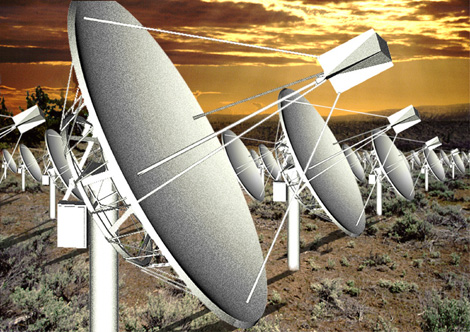“SETI 的历史 - 14”的版本间差异
小 |
|||
| 第4行: | 第4行: | ||
=='''第14章:SETI 的今天'''== | =='''第14章:SETI 的今天'''== | ||
| − | + | 只要 NASA 还在参与 [[SETI]] 的事务,即便只是使用它的一小部分资源,也会远远超出其它项目。即便是一些独立研究团体,比如 [[SETI 研究所]],往往也更愿意和 NASA 进行合作,而不是独立地开发自己的项目。但自从 HRMS 取消之后,一些新的、更具创新性的项目,比如 [[SETI@home]] 和 [[光学 SETI]](Optical SETI)已经崭露头角并在 SETI 的历史上占据了一席之地。 | |
| − | |||
| − | |||
| − | 只要 NASA 还在参与 SETI 的事务,即便只是使用它的一小部分资源,也会远远超出其它项目。即便是一些独立研究团体,比如 [[SETI 研究所]],往往也更愿意和 NASA 进行合作,而不是独立地开发自己的项目。但自从 HRMS 取消之后,一些新的、更具创新性的项目,比如 [[SETI@home]] 和 [[光学 SETI]](Optical SETI)已经崭露头角并在 SETI 的历史上占据了一席之地。 | ||
| − | |||
| − | |||
| − | |||
这些项目中有一些是由 SETI 联盟(SETI League)完成的。由大概 1300 个爱好者组成,联盟的目标是创建一个由业余 SETI 观测人员组成的网络,每个观测人员都使用各自的射电电线碟进行工作。最后,SETI 联盟希望能在全世界召集不少于 5000 个的 SETI 观测平台,但到目前为止,这个数字还只是 100 多,因此 SETI 联盟的这个项目,“Argus 项目”,还有很长的路要走。SETI 联盟还准备在北新泽西部署一组射电天线碟,他们称之为“Array 2k”,等到完成以后,这组天线阵列将作为一类新型的射电望远镜,专门用于 SETI 事业。 | 这些项目中有一些是由 SETI 联盟(SETI League)完成的。由大概 1300 个爱好者组成,联盟的目标是创建一个由业余 SETI 观测人员组成的网络,每个观测人员都使用各自的射电电线碟进行工作。最后,SETI 联盟希望能在全世界召集不少于 5000 个的 SETI 观测平台,但到目前为止,这个数字还只是 100 多,因此 SETI 联盟的这个项目,“Argus 项目”,还有很长的路要走。SETI 联盟还准备在北新泽西部署一组射电天线碟,他们称之为“Array 2k”,等到完成以后,这组天线阵列将作为一类新型的射电望远镜,专门用于 SETI 事业。 | ||
| − | |||
| − | |||
| − | |||
| 第22行: | 第13行: | ||
| − | [[Image:Allen_array.jpg|right|thumb|470px|'''艾伦望远镜阵列 | + | [[Image:Allen_array.jpg|right|thumb|470px|'''艾伦望远镜阵列'''<br> |
| − | 一位作家的假想图:黄昏下已全部建成的 ATA。图片提供:SETI 研究所 | + | 一位作家的假想图:黄昏下已全部建成的 ATA。图片提供:SETI 研究所]] |
| − | |||
| − | |||
| − | |||
| − | |||
ATA 代表着射电 SETI 项目的真正突破,作为一个专用观测站,SETI 研究人员将可以全年都用它来寻找外星信号,而 Phoenix 项目安放在阿雷西波的接收器每年只能工作几个星期。另外,由于它是由几百块独立的天线碟组成,这个阵列可以同时 | ATA 代表着射电 SETI 项目的真正突破,作为一个专用观测站,SETI 研究人员将可以全年都用它来寻找外星信号,而 Phoenix 项目安放在阿雷西波的接收器每年只能工作几个星期。另外,由于它是由几百块独立的天线碟组成,这个阵列可以同时 | ||
指向天空中的多个位置,也可以同时监听几个恒星的信号。最新的技术使 ATA 可以覆盖 9GHz 的频带,大概是 Phoenix 的三倍,也是现今所有搜索项目中最大的搜索频宽。所有这些都表示 SETI 搜索在容量上有了质的飞跃,探测到“真正的”外星信号的可能性也增加了七倍。 | 指向天空中的多个位置,也可以同时监听几个恒星的信号。最新的技术使 ATA 可以覆盖 9GHz 的频带,大概是 Phoenix 的三倍,也是现今所有搜索项目中最大的搜索频宽。所有这些都表示 SETI 搜索在容量上有了质的飞跃,探测到“真正的”外星信号的可能性也增加了七倍。 | ||
| − | |||
| − | |||
| − | |||
| 第40行: | 第24行: | ||
| − | [[SETI 的历史 - 13|'''第13章:NASA 后的SETI ←''']] | [[SETI 的历史|'''→ 返回 SETI 的历史''']] | + | [[SETI 的历史|'''返回 SETI 的历史 ←''']] | [[SETI 的历史 - 13|'''第13章:NASA 后的SETI ←''']] | [[SETI 的历史|'''→ 返回 SETI 的历史''']] |
| − | |||
| − | |||
| − | |||
| − | [[Category: | + | [[Category:SETI 相关文献]][[Category:文献翻译]] |
2010年8月2日 (一) 20:38的版本
<资料来源:The Planetary Society>
第14章:SETI 的今天
只要 NASA 还在参与 SETI 的事务,即便只是使用它的一小部分资源,也会远远超出其它项目。即便是一些独立研究团体,比如 SETI 研究所,往往也更愿意和 NASA 进行合作,而不是独立地开发自己的项目。但自从 HRMS 取消之后,一些新的、更具创新性的项目,比如 SETI@home 和 光学 SETI(Optical SETI)已经崭露头角并在 SETI 的历史上占据了一席之地。
这些项目中有一些是由 SETI 联盟(SETI League)完成的。由大概 1300 个爱好者组成,联盟的目标是创建一个由业余 SETI 观测人员组成的网络,每个观测人员都使用各自的射电电线碟进行工作。最后,SETI 联盟希望能在全世界召集不少于 5000 个的 SETI 观测平台,但到目前为止,这个数字还只是 100 多,因此 SETI 联盟的这个项目,“Argus 项目”,还有很长的路要走。SETI 联盟还准备在北新泽西部署一组射电天线碟,他们称之为“Array 2k”,等到完成以后,这组天线阵列将作为一类新型的射电望远镜,专门用于 SETI 事业。
ATA(艾伦望远镜阵列,Allen Telescope Array)是未来 SETI 的诸多项目中资金支持最好和最有希望的项目之一。它将要建在北加州喀斯喀特山上的 Hat Creek 观测站。ATA 是由加州大学伯克利分校和 SETI 研究所共同创立的,由微软公司创始人之一 Paul Allen 注资两千六百万美元。ATA 由 350 个射电天线碟组成,每个的直径大概是 6 米(20 英尺),等到全部完成以后,它的采集区域将和一个 100 米直径的天线碟相当。
ATA 代表着射电 SETI 项目的真正突破,作为一个专用观测站,SETI 研究人员将可以全年都用它来寻找外星信号,而 Phoenix 项目安放在阿雷西波的接收器每年只能工作几个星期。另外,由于它是由几百块独立的天线碟组成,这个阵列可以同时 指向天空中的多个位置,也可以同时监听几个恒星的信号。最新的技术使 ATA 可以覆盖 9GHz 的频带,大概是 Phoenix 的三倍,也是现今所有搜索项目中最大的搜索频宽。所有这些都表示 SETI 搜索在容量上有了质的飞跃,探测到“真正的”外星信号的可能性也增加了七倍。
SETI 研究在 1993 年 NASA 的项目被取消后遭受了重创,但多亏 SETI 研究所和行星协会的领导作用,这项事业得到了迅速的恢复。虽然再也不能使用 NASA 那么多的资源数量,但 SETI 项目也远离了依赖政府注资所带来的政治和资金风险。NASA 之后的 SETI 也许是一项更小的事业,但也变得更加多样化,变得更为世界各国的高等院校和科研单位所接受,也变得,就像 SETI@home 的成功所表明的,更为普通大众所接受。有了更广泛的根基和更大的号召力,今天的 SETI 事业比史上任何时候都
更为可靠。虽然目前还没有探测到任何外星信号,但希望仍在燃烧,搜索仍在继续...
